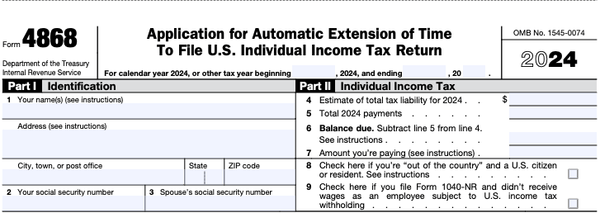Form 4868: Application for Automatic 6-Month Extension
Filing IRS Form 4868 gives you an automatic six-month extension to file your tax return. You can request an extension for free, but you still need to pay taxes owed by Tax Day.

Many, or all, of the products featured on this page are from our advertising partners who compensate us when you take certain actions on our website or click to take an action on their website. However, this does not influence our evaluations. Our opinions are our own. Here is a list of our partners and here's how we make money.
What is IRS Form 4868?
IRS Form 4868, also known as an “Application for Automatic Extension of Time to File,” is a document taxpayers can submit to the IRS if they need more time to file their individual federal tax returns.
The cut-off date to submit Form 4868 for the 2024 tax year is April 15, 2025. If you don't file for an extension in time, returns filed after the deadline are considered late.
A successful application extends your tax filing deadline from mid-April to mid-October. The form can be filed for free electronically or by mail.
5.0
NerdWallet rating- Federal: $79 to $139. Free version available for simple Form 1040 returns only.
- State: $0 to $69 per state.
- Expert help or full service filing is available with an upgrade to Live packages for a fee.
How does Form 4868 work?
Contrary to how it may sound, a tax extension won’t grant you more time to pay or deal with your tax bill. Submitting Form 4868 merely informs the agency that your tax return (typically Form 1040 and any related paperwork) will arrive late.
If you'll owe taxes, you'll need to estimate your tax bill and submit a payment by Tax Day along with your extension request.
Generally, your estimated payment should cover at least 90% of what you owe, and the remaining amount needs to be paid when you file your return. If your estimated payment doesn’t cover at least 90% of your liability, the IRS will charge interest and a late-payment penalty on the outstanding balance after Tax Day.
How much extra time does Form 4868 give you?
Form 4868 extends your tax filing deadline by six months, from mid-April to mid-October. The IRS generally doesn’t permit additional extensions beyond the initial six months. However, if you’re living abroad, serving in the military, or residing where a federally declared disaster occurred, you already may be eligible for an extension without having to ask for it.
When should I file Form 4868?
There are many reasons to consider filing Form 4868. The most common one is simply needing more time to collect paperwork. Other reasons include:
You, your CPA or your tax preparer will not be able to finish your tax return by the deadline.
You cannot file on time because of a significant life, medical or travel event.
You are missing or waiting on certain tax documents you need to file (e.g., a 1099 tax form or Schedule K-1).
You want to avoid incurring a failure-to-file penalty.
You are self-employed and want extra time to set up a SEP plan, which you may fund until the tax extension deadline. Solo 401(k)s and SIMPLE plans can also be funded until the extension deadline.
When not to file Form 4868
Filing Form 4868 doesn't make sense if you’re putting off your return because you can’t afford the tax bill. A tax extension request won’t give you more time to figure out that payment, so the longer you wait to file or pay after Tax Day passes, the more interest and penalties accumulate.
If you can’t afford a tax bill, try to file on time, pay as much as you can, and look into an IRS payment plan.
Who can file Form 4868?
Most taxpayers can file Form 4868 to request an automatic six-month tax filing extension. You don’t need to give a reason for requesting an extension, but if your request is denied, the IRS will contact you to let you know why.
5.0
NerdWallet rating- Federal: $79 to $139. Free version available for simple Form 1040 returns only.
- State: $0 to $69 per state.
- Expert help or full service filing is available with an upgrade to Live packages for a fee.
How to file Form 4868
There are several ways to submit Form 4868.
By paper: Taxpayers can file Form 4868 by mail, but it must be postmarked by Tax Day.
Electronically: IRS Free File, IRS Free Fillable Forms or tax-prep software can help you e-file your extension.
When you pay estimated taxes: This third option does away with the paperwork. When you pay your estimated tax bill using an IRS payment method such as Direct Pay, Electronic Federal Tax Payment System (EFTPS), or by credit or debit card, you can indicate that the payment is for an extension.
» MORE: 10 ways to make an IRS payment
What is the cost of filing Form 4868?
You can file a tax extension for free using IRS Free Fillable Forms online. Several IRS Free File providers also offer taxpayers free electronic extension filing, regardless of income level. You can also mail it in, which will mean paying for postage.
If you’re already committed to a particular tax-prep software, many brand-name providers also offer free extension filing, but they may collect fees for the service the closer you are to the tax filing deadline.
» MORE: How to file your taxes for free
How to fill out Form 4868
Form 4868 asks you to supply basic information, such as your name, address, Social Security number or individual taxpayer identification number (ITIN). If you owe taxes, you’ll also need to include an estimate of that bill and the amount of payment you’re making.
You can estimate your taxes by referencing how much you owed last year if your income has not changed drastically. You can also estimate your taxes using a tax calculator or tax-prep software. However, working with a tax pro or using IRS Form 1040-ES may ensure a closer estimate.

Where to download Form 4868
If you’re using tax software, most programs will help you fill out the form, tally your estimated taxes and e-file the form along with payment.
If you’re submitting a paper form, you can download a printable IRS Form 4868 directly from the agency's website.
Where to mail Form 4868
Filing a paper extension by mail requires a few additional steps. Once your form is ready, mail it to your state's applicable IRS or Treasury Department address.
If you’re sending in a payment with your request extension, the check or money order should be made out to the “United States Treasury.” Include your Social Security number and phone number, as well as a note that lists the tax year and what the check is for (e.g., 2024 Form 4868).
The IRS doesn't accept cash payments for paper extensions. For more information, see the Form 4868 instructions.
Don’t forget about the Form 4868 deadline
Knowing you’ve bought yourself a few extra months to file can bring relief, but don’t forget to mark your calendar with that new October deadline. If you miss the tax extension deadline, the IRS won’t offer additional options, and those fees and penalties will begin to pile up.

